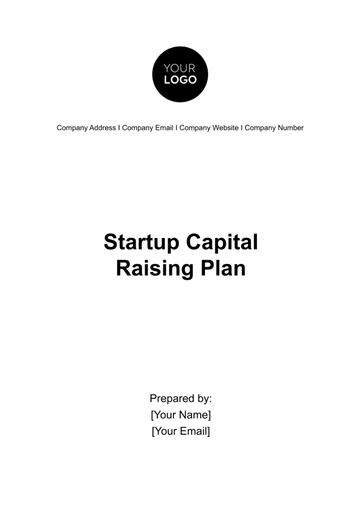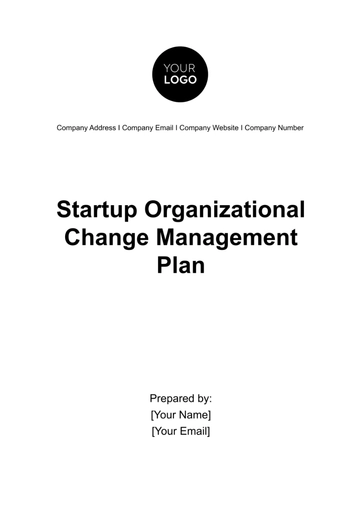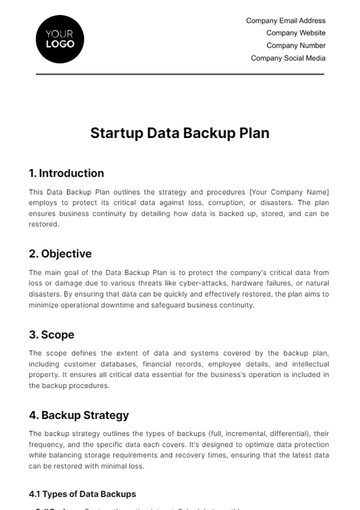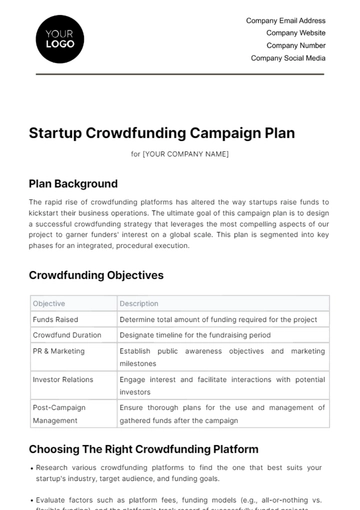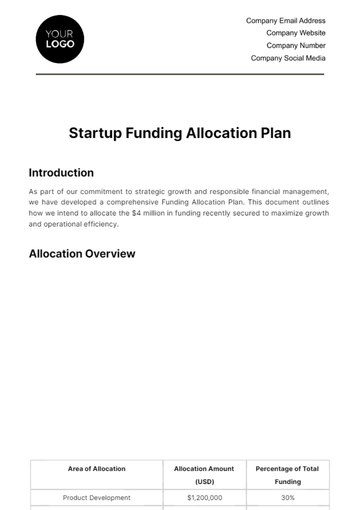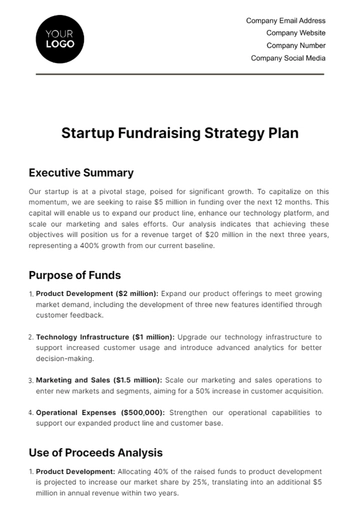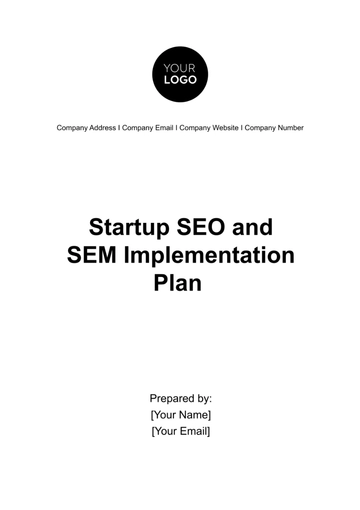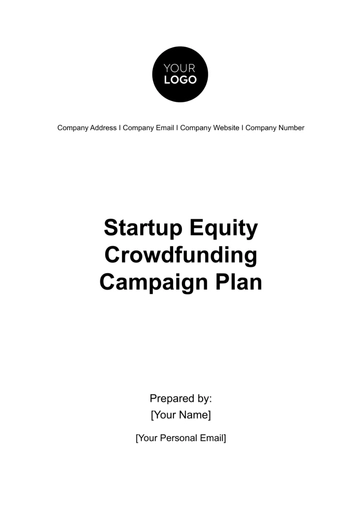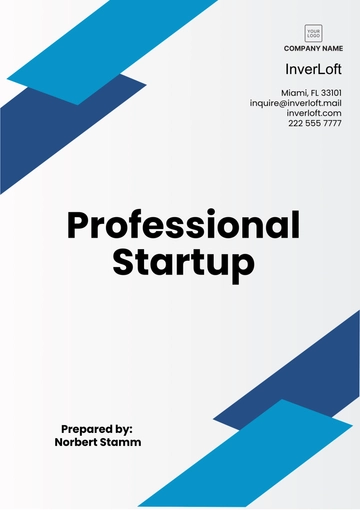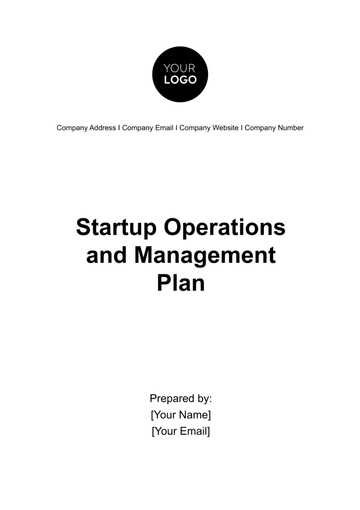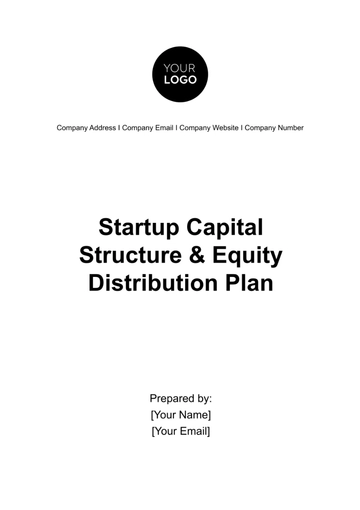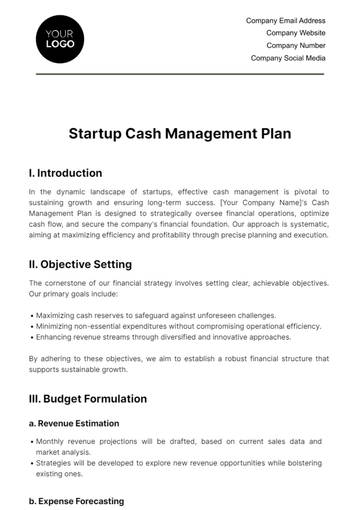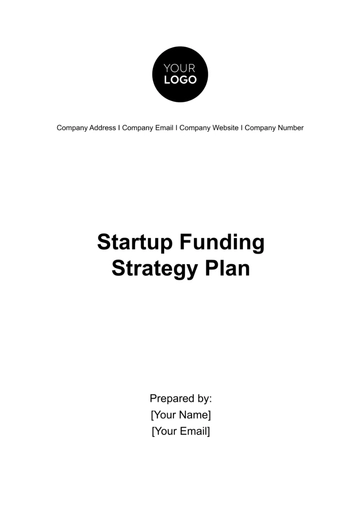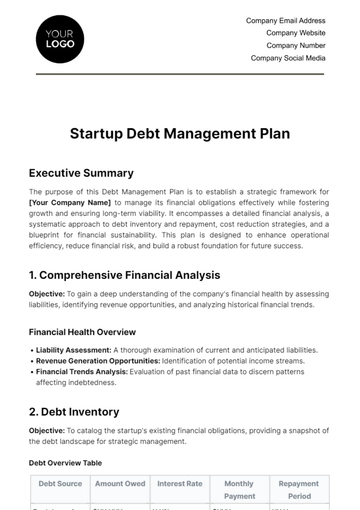Free Startup Funding Strategy Plan
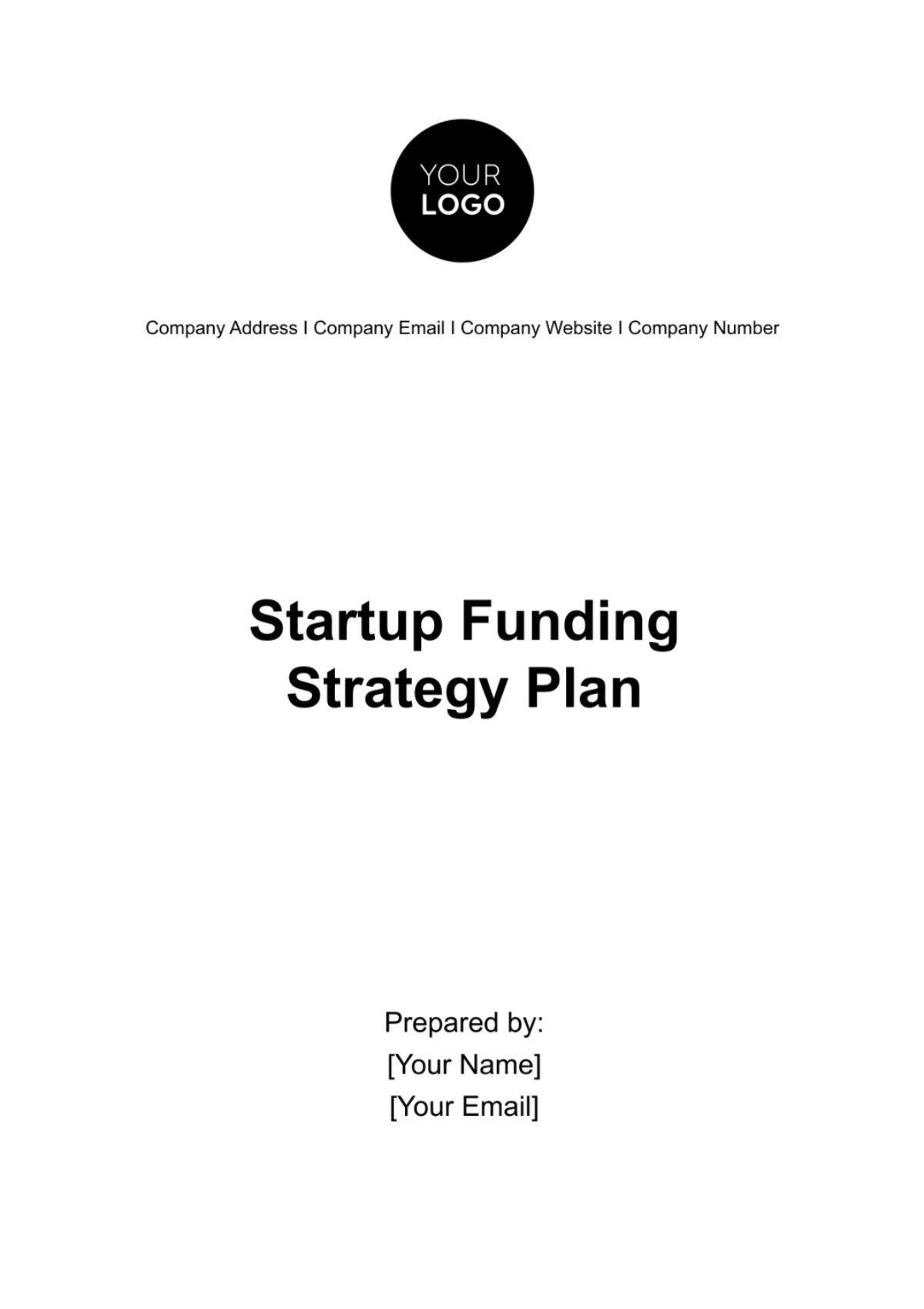
Executive Summary
This Startup Funding Strategy Plan, curated for [Your Company Name], is designed to offer a detailed and methodical framework for securing the essential capital required to support the initial phases of the company's growth. It outlines a series of steps and diversified strategies, aimed at facilitating the effective mobilization of financial resources critical to sustaining early-stage operational and developmental activities.
The plan integrates an analysis of potential funding sources, including venture capital, angel investors, crowdfunding, and government grants, with a tailored approach to match the specific financial needs and growth aspirations of the business. Through this funding strategy, [Your Company Name] aims to establish a solid financial foundation that enables scalable growth, fosters innovation, and enhances competitive positioning in the marketplace.
Identification of Funding Needs
The initial phase in the development of an effective fundraising strategy for [Your Company Name] involves a precise identification of the company's funding requirements. This critical analysis is foundational to the plan's success, as it informs the strategic direction and operational focus of the fundraising efforts.
Quantification of Financial Requirements
In this crucial phase, the process of accurately determining the total capital necessary to realize [Your Company Name]'s strategic ambitions is undertaken with rigorous detail. This involves an exhaustive budgetary analysis designed to map out the financial landscape of the company's journey ahead. It captures an in-depth projection of costs tied to operational activities, research and development efforts, strategies for entering new markets, and the investment in essential capital assets that underpin the company's expansion and innovation initiatives.
By pinpointing a precise financial goal, this methodology ensures the alignment of fundraising activities with the authentic fiscal needs of the enterprise. It serves as a safeguard against the risks of insufficient or excessive funding, both of which can derail the organization's progress and stability. Establishing a clearly defined financial benchmark is instrumental in guiding the strategic planning and execution of fundraising campaigns, ensuring they are finely tuned to the company's actual requirements.
Allocation and Timeline of Funds
The strategic allocation and timing of capital expenditure are foundational elements that necessitate detailed planning and forward-looking analysis. It specifies the investments earmarked for product innovation, the combination of marketing and brand-building endeavors, the acquisition of essential talent, and the fortification of operational infrastructure.
Each financial allocation is methodically planned to accelerate [Your Company Name] towards achieving its strategic benchmarks, facilitating various stages of product development, market expansion, and organizational scaling. To enhance understanding and provide a clear roadmap of the financial strategy, the following tables outline the projected allocation of funds and the corresponding timeline for their deployment:
Financial Allocation Overview:
Area of Investment | Allocated Funds |
|---|---|
Product Development | $500,000 |
Marketing and Brand Building | |
Talent Acquisition | |
Operational Infrastructure | |
Research and Development | |
Contingency Reserve | |
Total |
Timeline for Fund Deployment:
Phase | Date |
|---|---|
Product Development | [Date] - [Date] |
Marketing and Brand Building | |
Talent Acquisition | |
Operational Infrastructure | |
Research and Development | |
Contingency Reserve |
This financial plan and timeline are crafted with precision, aligning the infusion of capital with strategic growth phases and operational needs. By ensuring the availability of funds in sync with business milestones, [Your Company Name] is positioned to navigate the challenges of growth efficiently, optimizing its trajectory towards achieving long-term success and market leadership.
Evaluation of Funding Sources
This process involves an in-depth analysis of the advantages and disadvantages inherent to each funding avenue. Such analysis encompasses consideration of various factors, including but not limited to, the financial cost, the degree of control retained or relinquished, the obligations and commitments entailed, as well as the specific terms and conditions that govern each funding option. The objective of this evaluation is to align [Your Company Name]'s strategic goals with the most conducive financing structure, thereby fostering sustainable growth and development.
Venture Capital (VC): Offers substantial financial injections, typically suited for startups poised for rapid growth. While the capital benefits are significant, partnering with VC firms often entails relinquishing a portion of equity and control. Startups must weigh the value of VC investments against the potential dilution of founders' stakes and the influence on decision-making processes.
Angel Investors: Provide not only capital but also valuable mentorship and network access. These investors may demand less control compared to VC firms, offering a more flexible partnership. However, the investment amounts might be smaller, necessitating multiple rounds of funding to meet the startup's needs fully.
Crowdfunding: Emerges as a viable option for startups aiming to validate their market fit or product appeal directly through public support. This method can significantly enhance market visibility and community engagement without diluting equity. Nevertheless, successful crowdfunding campaigns require compelling storytelling and robust marketing efforts to capture public interest.
Loans and Credit Facilities: Represent a traditional funding route, offering the advantage of retaining full equity and control over the business. The challenge here lies in the repayment obligations, which can strain the financial health of a startup if not managed properly. Startups must ensure their cash flow projections and revenue models are solid enough to cover loan repayments.
In evaluating these funding sources, [Your Company Name] must consider its current stage of development, financial health, growth trajectory, and strategic objectives. The choice of funding source should meet the immediate financial needs and support the long-term vision of the company, ensuring a partnership that aligns with its values, operational philosophy, and growth aspirations.
Creating Financial Projections
This process involves the meticulous crafting of several key financial documents: a sales forecast, an expense budget, a cash-flow statement, income projections, and a break-even analysis. Together, these projections serve as a navigational compass, offering profound insights into the anticipated financial trajectory of the business.
Sales Forecast: This document outlines expected sales over a specific period, grounded in market research, historical sales data, and industry trends. It provides a foundation for estimating revenue and gauging market demand.
Expense Budget: A comprehensive budget that accounts for all anticipated costs and expenses associated with operating the business. This includes both fixed and variable costs, offering a clear picture of financial outlays necessary to maintain operations.
Cash-Flow Statement: This statement tracks the flow of cash in and out of the business, highlighting the operational liquidity and financial health. It is essential for understanding the timing of cash needs and ensuring that the business can sustain its operations and growth.
Income Projections: These projections provide an estimate of the company’s profitability over time, combining the sales forecast with the expense budget to illustrate expected net income.
Break-Even Analysis: A crucial analysis that determines the point at which the business’s revenues equal its expenses. This insight is vital for understanding the viability of the business model and for strategic planning.
These financial projections offer a comprehensive view of [Your Company Name]'s future financial health, guiding strategic decisions and investment considerations.
Investor Research
Compiling a researched list of potential investors is equally pivotal to the success of [Your Company Name]'s funding strategy. This list should be tailored to the business’s specific industry, developmental stage, and financing requirements. The objective is to identify investors who bring more than just capital to the table; the ideal partners also offer strategic advice, industry connections, and operational support conducive to the company's growth and scaling ambitions. The search for such investors requires a strategic approach, encompassing:
Industry Relevance: Targeting investors with a history of investment in your industry ensures an alignment of interest and expertise.
Stage Specialization: Seeking investors who specialize in your business's current stage, whether seed, early-stage, or growth, can provide tailored funding and support.
Value-Added Benefits: Prioritizing investors known for offering substantial post-investment support, such as mentorship, networking opportunities, and strategic guidance, can accelerate growth and development.
A well-constructed investor research process enables [Your Company Name] to approach funding with precision, ensuring that the pursuit of financial capital is complemented by strategic partnerships that foster long-term success and innovation. This careful alignment with the right investors not only secures the necessary financial resources but also enhances the company's strategic positioning and operational capabilities.
Pitch Preparation
Pitch Preparation for [Your Company Name] involves a strategic and detailed process to ensure the successful engagement of potential investors. This process can be delineated into the following steps:
Development of the Pitch Deck: Create a persuasive and well-structured pitch deck that effectively communicates the core aspects of your business. This includes:
A concise articulation of the business operational model.
Identification and analysis of the target market.
Presentation of the unique value proposition and competitive advantage.
Introduction of the founding team, highlighting their expertise and roles.
Provision of a clear and comprehensive financial outlook.
Presentation Rehearsal: Dedicate substantial time to practicing the delivery of your pitch. This preparation is critical for:
Building confidence in presenting the material.
Ensuring clarity in the communication of complex ideas.
Enhancing the ability to engage with the audience and respond to their cues.
Understanding and Anticipation: Deepen your understanding of every aspect of the business and anticipate potential investor inquiries. This step is vital for:
Demonstrating comprehensive knowledge of market dynamics, competitive landscape, and financial projections.
Preparing thoughtful and informed responses to potential questions or concerns, showcasing your adeptness in the business industry.
Reinforcing investor confidence in your capability to lead the business towards success.
By methodically following these steps, [Your Company Name] will be well-prepared to engage potential investors with a compelling presentation that highlights the business's strengths, opportunities, and readiness for investment.
Legal Preparation
Ensuring that [Your Company Name] is legally prepared is a fundamental step before initiating any investor engagement. This preparation underscores the integrity and professionalism of the business, significantly influencing investor confidence. The following detailed steps are essential for thorough legal preparation:
Business Registration and Structure: Confirm that [Your Company Name] is correctly registered according to the relevant state and federal laws. This includes choosing an appropriate business structure that aligns with your financial and operational goals. The right structure affects liability, taxation, and investment attraction capabilities.
Intellectual Property Protection: Secure your competitive edge by protecting intellectual property (IP). This involves:
Conducting comprehensive IP audits to identify all patentable inventions, trademarks, and copyrightable works.
Filing for patents and trademarks as necessary to safeguard your innovations and brand identity.
Implementing non-disclosure agreements (NDAs) and confidentiality measures to protect sensitive information.
Financial Transparency: Establish and maintain rigorous financial record-keeping practices. Ensure that all financial transactions are accurately recorded, and financial statements are prepared in accordance with Generally Accepted Accounting Principles (GAAP). Transparent and auditable financial records affirm your commitment to integrity and operational excellence.
Operational Licenses and Compliance: Verify that all necessary operational licenses are current and that the business complies with local, state, and federal regulations. This includes industry-specific licenses, environmental permits, and health and safety certifications. Compliance mitigates legal risks and affirms your business's legitimacy.
Investment Agreements and Shareholder Documents: Prepare clear and comprehensive investment agreements and shareholder documents. These documents should outline the terms of the investment, investor rights, and obligations, and any equity arrangements. Legal clarity in these agreements prevents future disputes and ensures mutual understanding between [Your Company Name] and its investors.
Legal Review and Advisory: Engage with legal professionals to review all preparation steps and documents. Legal counsel can provide crucial insights into potential risks, compliance issues, and strategies for protecting the business and its stakeholders. This partnership ensures that [Your Company Name] navigates the complex legal landscape effectively.
By adhering to these steps, [Your Company Name] demonstrates its commitment to legal and ethical business practices. This not only protects the company from potential legal pitfalls but also significantly enhances its attractiveness to investors by showcasing a well-organized, credible, and compliant enterprise.
Investor Outreach
The pursuit of investment for [Your Company Name] necessitates a strategic and nuanced approach to engaging potential investors. This endeavor transcends mere presentations; it demands a meticulously personalized strategy that aligns with the unique preferences and investment philosophies of each prospective investor. The following outlines a comprehensive approach to investor outreach:
Investor Identification: Start by compiling a list of potential investors who have shown interest in your industry or have a history of supporting ventures at your stage of growth. This list should include venture capitalists, angel investors, strategic investors, and other financial entities relevant to your business domain.
Research and Segmentation: Conduct in-depth research on each identified investor to understand their investment criteria, past investment history, focus areas, and what they look for in a potential investment. Segment your investor list based on their investment focus areas, preferred investment stage, and other relevant criteria to tailor your approach effectively.
Customized Communication Strategy: Develop a customized communication plan for each segment of investors. This involves creating personalized pitches that highlight how [Your Company Name]'s value proposition and growth potential align with their investment philosophy and goals.
Engagement Plan: Determine the most appropriate method and timing for initiating contact with each investor. Plan your outreach efforts to include personalized emails, direct calls, or introductions through mutual connections. Ensure that each communication is respectful of the investor's time and preferences.
Follow-Up Strategy: Implement a structured follow-up strategy to maintain engagement with potential investors who express interest. Schedule follow-up meetings, provide additional information as requested, and keep them updated on your progress and milestones.
Investor Outreach Framework:
To facilitate this strategy, the table below provides a framework for organizing the outreach process:
Investor Segment | Focus Areas | Initial Contact Method | Follow-Up Plan |
|---|---|---|---|
Venture Capitalists | Technology, Healthcare | Personalized Email | Schedule Meeting within 2 Weeks |
This structured approach to investor outreach emphasizes the importance of personalization, strategic alignment, and respectful engagement. By tailoring the communication and approach to the specific interests and investment strategies of potential investors, [Your Company Name] maximizes its chances of securing the necessary funding and strategic partnerships for sustained growth and success.
Follow-up and Negotiation
Effective follow-up and negotiation strategies are pivotal after initial engagements with potential investors for [Your Company Name]. This phase is critical in transforming initial interest into tangible investment commitments.
Follow-up Strategy
Maintaining Engagement: Post-pitch, it's crucial to keep all potential investors informed about [Your Company Name]'s ongoing progress, achievements, and milestones. Regular updates, structured as newsletters or brief reports, should highlight key developments, any new partnerships, product advancements, or market expansions. This consistent communication keeps the startup at the forefront of investors' minds and demonstrates a commitment to transparency and progress.
Personalized Updates: Tailor updates to reflect aspects of [Your Company Name] that specifically resonated with each investor during the initial pitch. Personalization shows attentiveness to the investor's interests and can strengthen the relationship.
Transition to Negotiation: When an investor signals interest in proceeding, the conversation should gracefully pivot to discussing investment terms, valuation, and other pertinent details. This transition must be handled with tact, emphasizing a collaborative approach to arrive at mutually agreeable terms.
Negotiation Tactics
Preparation and Research: Enter negotiations with a well-researched valuation of [Your Company Name], understanding both your position and the investor's typical deal structures. Be ready to discuss and justify your startup's valuation with data and market comparisons.
Flexibility and Openness: While it's important to have clear goals, approaching negotiations with flexibility can lead to more favorable terms for both parties. Open discussions about terms, expectations, and potential deal structures can uncover creative solutions that satisfy both sides.
Legal and Financial Advice: Consult with financial advisors and legal counsel to understand the implications of various terms and conditions. Their expertise will be invaluable in navigating complex negotiations and ensuring that the agreement supports [Your Company Name]'s long-term objectives.
By meticulously navigating the follow-up and negotiation processes, [Your Company Name] can secure the necessary capital while establishing strong, collaborative relationships with its investors. This strategic approach ensures not only the successful acquisition of funds but also sets the foundation for sustainable growth and long-term success.
Funding Closure
Securing funding is a pivotal moment for [Your Company Name], marking both a culmination of extensive preparation and the beginning of a new chapter in its growth trajectory. The closure of funding, however, requires meticulous attention to ensure that all agreements are legally sound and beneficial to all parties involved.
Legal Due Diligence: Upon reaching an agreement on terms that are mutually beneficial, it is imperative to conduct thorough legal due diligence. Engaging a reputable legal team to scrutinize the terms, contracts, and any associated legal documents is crucial. This step ensures that all agreements are in compliance with relevant laws and regulations, and that [Your Company Name]'s interests are adequately protected.
Contract Review and Finalization: Before finalizing the deal, have your legal team conduct a detailed review of all contractual documents. This review should focus on verifying the accuracy of terms, identifying any potential liabilities, and ensuring that the contractual obligations are clear and manageable. Only after thorough examination and when all parties have a clear understanding of the terms should the contracts be signed.
Celebration and Acknowledgment: The successful closure of funding is a significant achievement that warrants recognition. Celebrating this milestone not only acknowledges the hard work and dedication of the team but also strengthens the bond with your new investors. A gesture of appreciation or a formal acknowledgment can go a long way in fostering a positive and collaborative investor relationship.
Execution and Transparency: With the funding secured, the immediate focus shifts to executing the plans and initiatives outlined in your pitch. Demonstrating commitment to your promises is crucial for maintaining investor confidence and support. Regular updates on progress, transparent communication about challenges, and consistent financial reporting are key to building trust and ensuring a productive partnership.
Conclusion
The successful closure of funding for [Your Company Name] is not merely the end of the fundraising process but the beginning of a promising journey towards achieving the company's strategic objectives. However, the true measure of success post-funding lies in the effective execution of plans, maintaining strong investor relationships, and navigating the path forward with integrity and transparency. By adhering to these principles, [Your Company Name] is well-positioned to leverage its newly acquired resources to fuel its vision, drive innovation, and achieve sustained success in its endeavors.
- 100% Customizable, free editor
- Access 1 Million+ Templates, photo’s & graphics
- Download or share as a template
- Click and replace photos, graphics, text, backgrounds
- Resize, crop, AI write & more
- Access advanced editor
Craft a compelling roadmap to secure financing with Template.net's Startup Funding Strategy Plan Template. This editable and customizable template guides you through developing a comprehensive strategy for attracting investors, including identifying target funding sources and outlining your approach. Tailor your funding plan using our Ai Editor Tool, ensuring alignment with your startup's goals and market potential.
You may also like
- Finance Plan
- Construction Plan
- Sales Plan
- Development Plan
- Career Plan
- Budget Plan
- HR Plan
- Education Plan
- Transition Plan
- Work Plan
- Training Plan
- Communication Plan
- Operation Plan
- Health And Safety Plan
- Strategy Plan
- Professional Development Plan
- Advertising Plan
- Risk Management Plan
- Restaurant Plan
- School Plan
- Nursing Home Patient Care Plan
- Nursing Care Plan
- Plan Event
- Startup Plan
- Social Media Plan
- Staffing Plan
- Annual Plan
- Content Plan
- Payment Plan
- Implementation Plan
- Hotel Plan
- Workout Plan
- Accounting Plan
- Campaign Plan
- Essay Plan
- 30 60 90 Day Plan
- Research Plan
- Recruitment Plan
- 90 Day Plan
- Quarterly Plan
- Emergency Plan
- 5 Year Plan
- Gym Plan
- Personal Plan
- IT and Software Plan
- Treatment Plan
- Real Estate Plan
- Law Firm Plan
- Healthcare Plan
- Improvement Plan
- Media Plan
- 5 Year Business Plan
- Learning Plan
- Marketing Campaign Plan
- Travel Agency Plan
- Cleaning Services Plan
- Interior Design Plan
- Performance Plan
- PR Plan
- Birth Plan
- Life Plan
- SEO Plan
- Disaster Recovery Plan
- Continuity Plan
- Launch Plan
- Legal Plan
- Behavior Plan
- Performance Improvement Plan
- Salon Plan
- Security Plan
- Security Management Plan
- Employee Development Plan
- Quality Plan
- Service Improvement Plan
- Growth Plan
- Incident Response Plan
- Basketball Plan
- Emergency Action Plan
- Product Launch Plan
- Spa Plan
- Employee Training Plan
- Data Analysis Plan
- Employee Action Plan
- Territory Plan
- Audit Plan
- Classroom Plan
- Activity Plan
- Parenting Plan
- Care Plan
- Project Execution Plan
- Exercise Plan
- Internship Plan
- Software Development Plan
- Continuous Improvement Plan
- Leave Plan
- 90 Day Sales Plan
- Advertising Agency Plan
- Employee Transition Plan
- Smart Action Plan
- Workplace Safety Plan
- Behavior Change Plan
- Contingency Plan
- Continuity of Operations Plan
- Health Plan
- Quality Control Plan
- Self Plan
- Sports Development Plan
- Change Management Plan
- Ecommerce Plan
- Personal Financial Plan
- Process Improvement Plan
- 30-60-90 Day Sales Plan
- Crisis Management Plan
- Engagement Plan
- Execution Plan
- Pandemic Plan
- Quality Assurance Plan
- Service Continuity Plan
- Agile Project Plan
- Fundraising Plan
- Job Transition Plan
- Asset Maintenance Plan
- Maintenance Plan
- Software Test Plan
- Staff Training and Development Plan
- 3 Year Plan
- Brand Activation Plan
- Release Plan
- Resource Plan
- Risk Mitigation Plan
- Teacher Plan
- 30 60 90 Day Plan for New Manager
- Food Safety Plan
- Food Truck Plan
- Hiring Plan
- Quality Management Plan
- Wellness Plan
- Behavior Intervention Plan
- Bonus Plan
- Investment Plan
- Maternity Leave Plan
- Pandemic Response Plan
- Succession Planning
- Coaching Plan
- Configuration Management Plan
- Remote Work Plan
- Self Care Plan
- Teaching Plan
- 100-Day Plan
- HACCP Plan
- Student Plan
- Sustainability Plan
- 30 60 90 Day Plan for Interview
- Access Plan
- Site Specific Safety Plan










